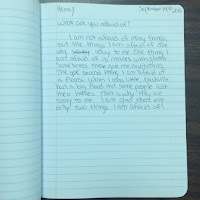While reading through the comments on this blog post, I discovered the book Teaching Conflict Resolution Through Children's Literature and the idea of the "conflict escalator". Especially when conflict was a bigger problem at our school, it seemed like our students were constant escalating their problems unknowingly! This seemed like a great lesson topic for 3rd grade's conflict resolution unit.
This was a lesson I wanted to start with a book but had a difficult time finding the perfect one. I needed something that showed not just the cycle and effect of conflict, but the escalation of conflict. While I would still love to find one that has more real world examples, The Butter Battle Book ended up working as a great start. After reading the book, I asked them:
Then the students move to their desks and I introduce the concept of the conflict escalator using a PowerPoint. Not all of my students have been to big malls and most have not been to airports, so it was important I be able to give them a visual! We walked through the vocabulary of escalating vs. de-escalating. I added in the weather visuals to tie in with our size of problems lesson and learning.
The next step was to go through two story examples. The stories are adaptations of stories I found over and over again when googling the teaching of this topic - just changed the specifics to be a fit to my school.
First I read aloud while students acted it out. Then I read it aloud again and students motioned whenever a character said or did something that escalated the conflict and made it worse. I flashed these up the steps on the PPT as we went. After finishing the story, I asked them to come point out one or two star locations and give an example of how the character could have made a different choice to de-escalate the conflict.
Our final activity was for students to work in pairs or trios to sort words and actions that would escalate vs. de-escalate conflict, and then to personally identify 1 or 2 escalation cards that they were "guilty" of doing during conflict. Cards are available here in my TpT store.
Closing questions (if time):
This was a lesson I wanted to start with a book but had a difficult time finding the perfect one. I needed something that showed not just the cycle and effect of conflict, but the escalation of conflict. While I would still love to find one that has more real world examples, The Butter Battle Book ended up working as a great start. After reading the book, I asked them:
- At the beginning of the story, what was the problem or conflict about?
- At the end of the story, what was the problem or conflict about?
- Did the size of the conflict or problem stay the same or change during the story? Did it get bigger or smaller?
- The conflict kept going and growing. Did it have to? Or could the Zooks or Yooks have done something to make the conflict smaller or stop?
Then the students move to their desks and I introduce the concept of the conflict escalator using a PowerPoint. Not all of my students have been to big malls and most have not been to airports, so it was important I be able to give them a visual! We walked through the vocabulary of escalating vs. de-escalating. I added in the weather visuals to tie in with our size of problems lesson and learning.
The next step was to go through two story examples. The stories are adaptations of stories I found over and over again when googling the teaching of this topic - just changed the specifics to be a fit to my school.
First I read aloud while students acted it out. Then I read it aloud again and students motioned whenever a character said or did something that escalated the conflict and made it worse. I flashed these up the steps on the PPT as we went. After finishing the story, I asked them to come point out one or two star locations and give an example of how the character could have made a different choice to de-escalate the conflict.
Our final activity was for students to work in pairs or trios to sort words and actions that would escalate vs. de-escalate conflict, and then to personally identify 1 or 2 escalation cards that they were "guilty" of doing during conflict. Cards are available here in my TpT store.
Closing questions (if time):
- Which is easier to do, escalate or de-escalate conflict?
- Why do people sometimes choose to escalate conflict?
- Why should we choose to de-escalate conflict instead of escalate it?






















